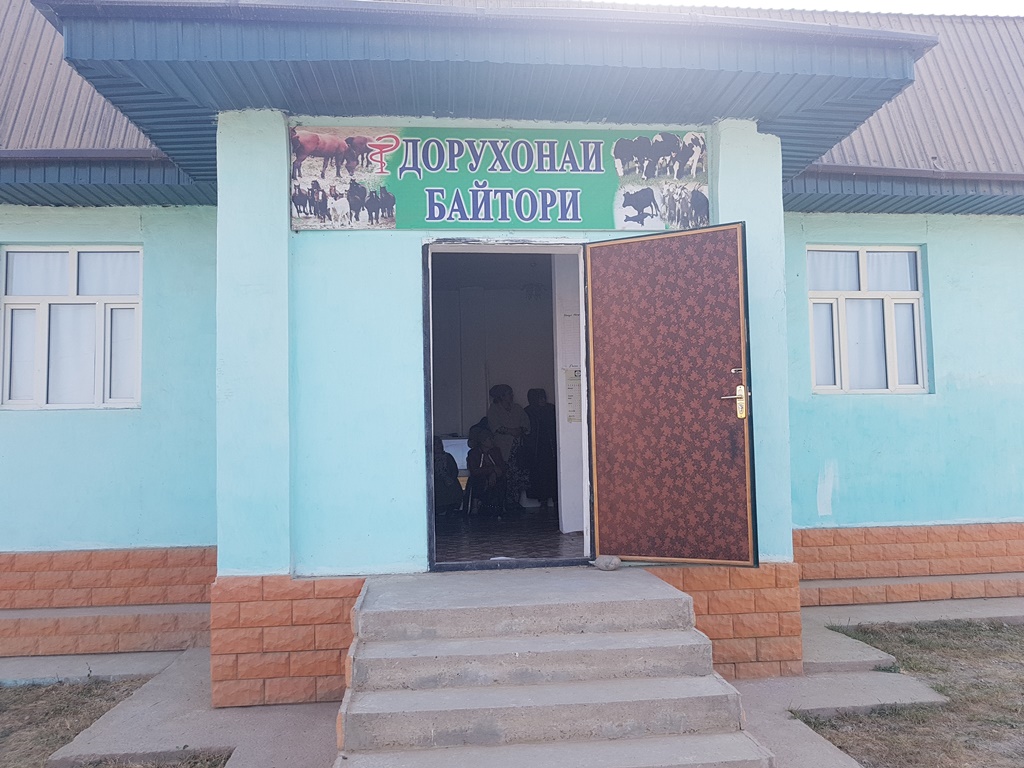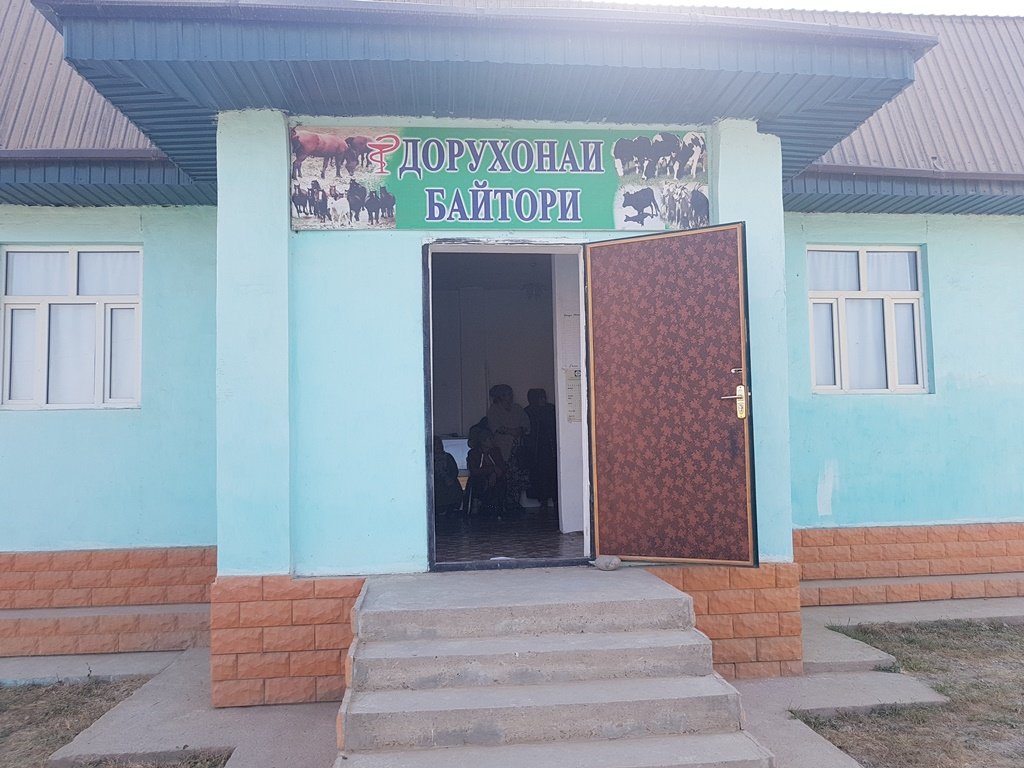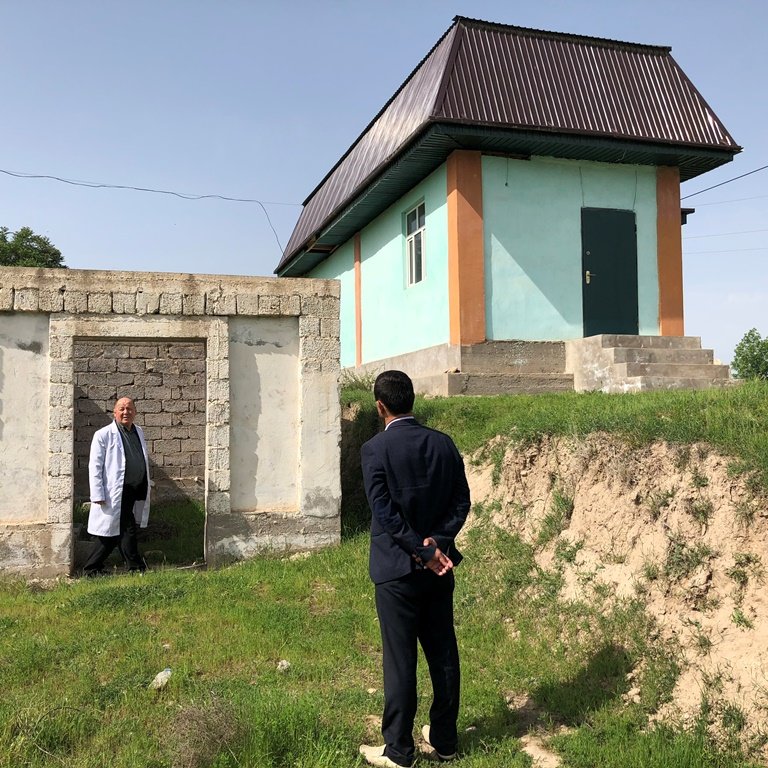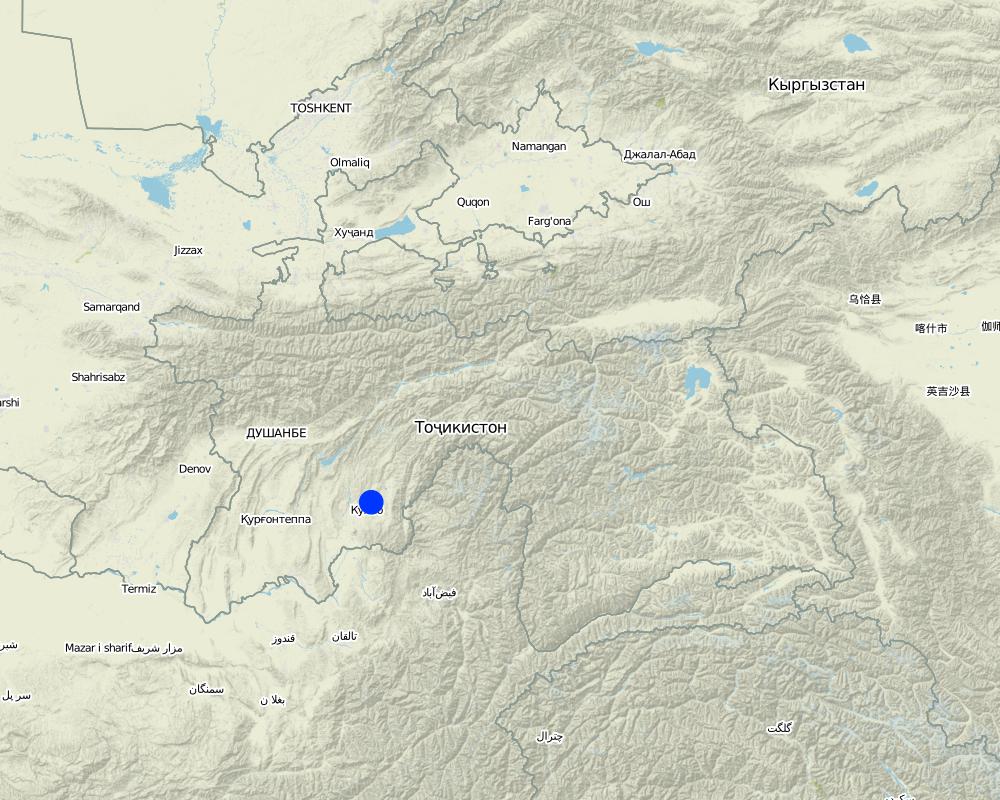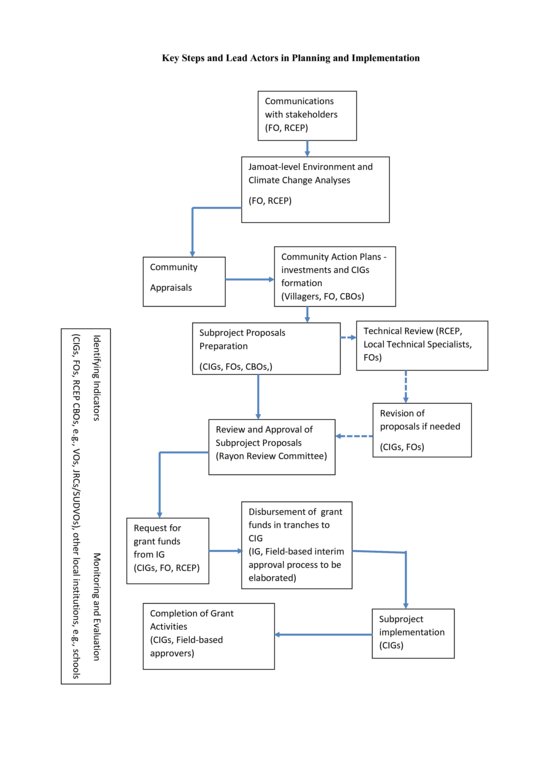Veterinary clinic contributing to the health level of the livestock and improved pastures through prevention activities [Tajikistan]
- Creation:
- Update:
- Compiler: Kamolidin Abdulloev
- Editor: –
- Reviewer: Farrukh Nazarmavloev
Дорухонаи байтори
approaches_3903 - Tajikistan
View sections
Expand all Collapse all1. General information
1.2 Contact details of resource persons and institutions involved in the assessment and documentation of the Approach
Name of project which facilitated the documentation/ evaluation of the Approach (if relevant)
Environmental Land Management and Rural Livelihoods (ELMAR)Name of the institution(s) which facilitated the documentation/ evaluation of the Approach (if relevant)
Committee for Environment Protection of Tajikistan (Committee for Environment Protection of Tajikistan) - Tajikistan1.3 Conditions regarding the use of data documented through WOCAT
When were the data compiled (in the field)?
24/06/2018
The compiler and key resource person(s) accept the conditions regarding the use of data documented through WOCAT:
Yes
2. Description of the SLM Approach
2.1 Short description of the Approach
Improvement of the level of care and breeding cattle by opening a veterinary drugstore by this way to support livestock keepers somehow control pastures lands and livestock quantity
2.2 Detailed description of the Approach
Detailed description of the Approach:
Animal diseases would not mention by livestock keepers as a problem. Likely because they themselves perceive the present losses as unavoidable. The veterinary staff, however, estimates the annual losses of livestock due to diseases at 5-10%. Reasons given for this is that vaccines are often not made available for entire herd populations, but are only sufficient for around 70% of the total number of animals. Furthermore are some vaccination only carried out in case of an outbreak of disease (ring vaccination) and not as a routine. It was also noted that the privatization of veterinary services is problematic as the taxation of services is making it difficult for the vets in the rural areas to make a living out of their service provision. According to data infections diseases, such as gangrene, foot and mouth disease, brucellosis and other infectious diseases were registered in this rural area so depending on the season monitoring is conducted. Except for infectious diseases, there are other parasites infections are met in this rural area. In the case of not carrying out vaccination in a timely manner they will be spread, as well as failure to timely prevent other diseases leads to the loss of livestock, which will also reduce the economic level of the population and their living. This was the first problem, the second and the main is the balancing of fodder and livestock, and only villagers need to discuss how either the production of fodder can be increased or the number of animals can be reduced in order to achieve the potential production level of the animals, for which balancing fodder and number of livestock is a precondition. There are several options for how the balance between fodder and animals can be restored. The villagers need to have a plan and it would stipulate controlled grazing measures, this group does not have a plan but they some of the prevention activities. As the result of the approach, they opened livestock registered book that they regularly monitored the number of the livestock, calendar with the type of disease season, breeding process, mortality of the livestock, artificial insemination of animals at the clinic is planned to open, and species of birds. Additionally, vet clinic group specialists have been trained a different type of the training on; pasture assessment practical, how to develop and implement a scheme for rotational grazing, how to monitor potential pasture yields, determining the quality of fodder and feeds, housing process and so on. On behalf of the project for the representatives all the groups been provided composting, mulching, managing salinization, intercropping on slopes, drip irrigation, low-cost watering techniques, solar greenhouses, drought-resistant crops, bee-keeping, mixed fruit orchards, local varieties nurseries, rotational grazing, livestock breeding and maintaining, strategic watering points, use of perennial forage, solar energy technologies, marketing options and opportunities trainings through the facilitation organisation
2.3 Photos of the Approach
2.5 Country/ region/ locations where the Approach has been applied
Country:
Tajikistan
Region/ State/ Province:
Kulob Region, Kulob District
Further specification of location:
Ziraki Jamoat, Gulbogh Village
Comments:
An approach implemented in Kulob district, Jamoat Ziraki, Gubogh village
Map
×2.6 Dates of initiation and termination of the Approach
Indicate year of initiation:
2015
Year of termination (if Approach is no longer applied):
2017
Comments:
While carrying out preventive measures and treatment of farm animals rural people spend their service fees for the purchase of medicines and equipment. In the future, the head of the group is responsible to care of and make the veterinary clinic operation more sustainable.
2.7 Type of Approach
- project/ programme based
2.8 Main aims/ objectives of the Approach
The main goal of approach is to prevent infectious diseases of animals in a timely manner and infection of domestic animals, as well as to provide treatment and preventive measures for infectious diseases, such as immunization of cattle and small cattle and improving pasture lands through prevention activities
2.9 Conditions enabling or hindering implementation of the Technology/ Technologies applied under the Approach
social/ cultural/ religious norms and values
- hindering
Besides, to purchase and increase good breeds of cattle adapted to the climate in this region. It is worth to note that the rural people were not aware of veterinary information. That resulted in that infectious diseases were spread because the population had eaten meat or sold in the market. Along with the implementation of this subproject these problems are disappearing.
institutional setting
- hindering
Non of institutions was functionedThe CIG head is Isroil Nazarov and an accountant is Hussein Abdurahmonov. They are responsible for the subproject activities implementation, make all their efforts and put their enthusiasm for the successful implementation. While carrying out preventive measures and treatment of farm animals rural people spend their service fees for the purchase of medicines and equipment. In the future, the head of the group is responsible to care of and make the veterinary clinic operation more sustainable.
knowledge about SLM, access to technical support
- hindering
The livestock keepers and land users does not have sufficient knowledge to manage their lands On behalf of the project for the reprezentatives all the groups been provided composting, mulching, managing salinization, inter cropping on slopes, drip irrigation, low-cost watering techniques, solar greenhouses, drought resistant crops, bee-keeping, mixed fruit orchards, local varieties nurseries, rotational grazing, livestock breeding and maintaining, strategic watering points, use of perennial forage, solar energy technologies, marketing options and opportunities trainings through the facilitation organisation
3. Participation and roles of stakeholders involved
3.1 Stakeholders involved in the Approach and their roles
- local land users/ local communities
CIG Members
The CIG head is Isroil Nazarov and an accountant is Hussein Abdurahmonov. They are responsible for the subproject activities implementation, make all their efforts and put their enthusiasm for the successful implementation. While carrying out preventive measures and treatment of farm animals rural people spend their service fees for the purchase of medicines and equipment. In the future, the head of the group is responsible to care of and make the veterinary clinic operation more sustainable.
- SLM specialists/ agricultural advisers
FOs and Academys
Reprezentatives been involved during the TOT trainings
- NGO
FOs
FOs provided their services to facilitate community mobilization, and preparation and implementation of sub-projects, as well as to strengthen the capacity of community based groups to undertake their respective project responsibilities
- local government
Local hukumat and Jamoat
Jamoat representatives was involved in Participatory Rural Appraisal (PRA) that was used as the main pre-assessment mechanism to analyze socio-economic and environmental situation in the selected pilots, The RRC(Rayon Reviw Committee) will consider the combination of proposed sub-projects within the overall context of the rayon and project.
3.2 Involvement of local land users/ local communities in the different phases of the Approach
| Involvement of local land users/ local communities | Specify who was involved and describe activities | |
|---|---|---|
| initiation/ motivation | interactive | There are 274 households residing in the village with the total number of 2225 people. The CIG head is Isroil Nazarov. He is as the specialist responsible for the subproject/approach activities implementation, make all their efforts and put their enthusiasm for the successful implementation |
| planning | passive | The local land users prioritized investments based on a fixed budget for each type of rural investment determined by the number of households and on behalf of the CAP participants decided on the allocation of investments to groups of households (Common Interest Groups, CIGs) using rules that limit the funding for any one household. At least 50% of the village households should participate in either farm production or land resource management investments. |
| implementation | interactive | Villagers made grant allocation decisions. CIGs managed grant funds and purchased needed materials and products. |
| monitoring/ evaluation | passive | Local land users have activelly participated during the monitoring |
3.3 Flow chart (if available)
Description:
Here is the key steps and actors in the planning and implementation of rural investments. Not all possible participants in these steps are included since local situations may vary and will need to be taken into account during planning and implementation.
Author:
ELMARL POM
3.4 Decision-making on the selection of SLM Technology/ Technologies
Specify who decided on the selection of the Technology/ Technologies to be implemented:
- mainly land users, supported by SLM specialists
Explain:
The local land users prioritized investments based on a fixed budget for each type of rural investment determined by the number of households and on behalf of the CAP participants decided on the allocation of investments to groups of households (Common Interest Groups, CIGs) using rules that limit the funding for any one household
Specify on what basis decisions were made:
- evaluation of well-documented SLM knowledge (evidence-based decision-making)
- Project initial phases
4. Technical support, capacity building, and knowledge management
4.1 Capacity building/ training
Was training provided to land users/ other stakeholders?
Yes
Specify who was trained:
- land users
- field staff/ advisers
If relevant, specify gender, age, status, ethnicity, etc.
Provided participation of the male and female during the training process
Form of training:
- on-the-job
- farmer-to-farmer
- public meetings
Subjects covered:
Grant allocation mechanisms. Fund flow arrangements, management and technical
Comments:
Trainings included such king themes; composting, mulching, managing salinization, intercropping on slopes, drip irrigation, low-cost watering techniques, solar greenhouses, drought-resistant crops, bee-keeping, mixed fruit orchards, local varieties nurseries, rotational grazing, Livestock breeding and maintaining, strategic watering points, use of perennial forage, solar energy technologies, marketing options and opportunities,
4.2 Advisory service
Do land users have access to an advisory service?
Yes
Specify whether advisory service is provided:
- on land users' fields
- at permanent centres
Describe/ comments:
Jamoat representatives and also local vet specialists from the district advise them
4.3 Institution strengthening (organizational development)
Have institutions been established or strengthened through the Approach?
- yes, a little
Specify the level(s) at which institutions have been strengthened or established:
- local
Describe institution, roles and responsibilities, members, etc.
The Common Interest Groups formed in the villages on behalf households and enhanced their knowledge. And the project provides small-scale grants at the village level for groups of households (CIG) to implement rural production and land management investments, as well as related small-scale infrastructure investments. Villages will prioritize investments based on a fixed budget for each type of rural investment, determined by the number of households.
Specify type of support:
- financial
- capacity building/ training
Give further details:
Project-financed grants to CIGs for each investment under categories of rural production and land management investments, as well as related small-scale infrastructure investments that will not exceed US$7,000 and will require a match of 25% in beneficiary contributions which may be in cash or in-kind
4.4 Monitoring and evaluation
Is monitoring and evaluation part of the Approach?
No
4.5 Research
Was research part of the Approach?
No
5. Financing and external material support
5.1 Annual budget for the SLM component of the Approach
If precise annual budget is not known, indicate range:
- 2,000-10,000
Comments (e.g. main sources of funding/ major donors):
GEF/PPCR through the WB
5.2 Financial/ material support provided to land users
Did land users receive financial/ material support for implementing the Technology/ Technologies?
Yes
If yes, specify type(s) of support, conditions, and provider(s):
The project will finance investments in three categories that are expected to improve household assets and sustainable land management, and build climate resilience, examples ofwhich are listed below: (i) Farm Production: field and horticultural crop productivity and diversity (e.g., crop rotations, drought resistant varieties, diversified cropping regimes, community seed funds, low-cost greenhouses), livestock production efficiency (e.g., breed choice, veterinary services), agro-processing and market access;(ii) Land Resource Management: pasture management (e.g., fodder productivity through appropriate species, rotational grazing, watering holes, growing perennials on slopes), watermanagement (e.g., drip irrigation and similar measures, water harvesting), soil fertility (e.g.,composting, mulch crops) integrated pest management (e.g., use of pheromone traps,biological controls) and sustainable sloping lands cultivation (including terracing, inter cropped orchards and woodlots, shelter-belts); and (iii) Small-scale Rural Production Infrastructure: irrigation/drainage system rehabilitation, minor transport infrastructure rehabilitation (e.g., repair of bridges), renewable energy (e.g.,low cost solar energy, and energy efficiency measures (e.g., improved stoves, insulation).Project-financed grants to CIGs for each investment under categories (i), (ii), and (iii) will not exceed US$7,000 and will require a match of 25% in beneficiary contributions which may be in cash or in-kind. Beneficiaries of rural infrastructure investments (category iii above) will have to contribute at least 5% of the total cost in cash at inception. Grants under this subcomponent will be disbursed in tranches directly to beneficiaries or groups to their own bank account with Amonatbank that has branches in most districts.
5.3 Subsidies for specific inputs (including labour)
- none
If labour by land users was a substantial input, was it:
- voluntary
Comments:
The CIG group contributed more then 25 % from the total subproject/approach
5.4 Credit
Was credit provided under the Approach for SLM activities?
No
5.5 Other incentives or instruments
Were other incentives or instruments used to promote implementation of SLM Technologies?
No
6. Impact analysis and concluding statements
6.1 Impacts of the Approach
Did the Approach empower local land users, improve stakeholder participation?
- No
- Yes, little
- Yes, moderately
- Yes, greatly
There are 274 households residing in the village with total number of 2225 people. The CIG head is Isroil Nazarov and an accountant is Hussein Abdurahmonov. They are responsible for the subproject activities implementation, make all their efforts and put their enthusiasm for the successful implementation. While carrying out preventive measures and treatment of farm animals rural people spend their service fees for the purchase of medicines and equipment. In the future, the head of the group is responsible to care of and make the veterinary clinic operation more sustainable
On behalf of the project for the reprezentatives all the groups been provided composting, mulching, managing salinization, inter cropping on slopes, drip irrigation, low-cost watering techniques, solar greenhouses, drought resistant crops, bee-keeping, mixed fruit orchards, local varieties nurseries, rotational grazing, livestock breeding and maintaining, strategic watering points, use of perennial forage, solar energy technologies, marketing options and opportunities trainings through the facilitation organisation that will contribute to implement and maitain apprach
Did the Approach improve knowledge and capacities of land users to implement SLM?
- No
- Yes, little
- Yes, moderately
- Yes, greatly
Trainings were organized and most of them had direct and indirect relation to SLM projects
6.2 Main motivation of land users to implement SLM
- increased production
The vet specialists will advise livestock keepers regarding the new breeds and also the timely manner of the vaccination process will contribute to the productivity of the livestock
- reduced land degradation
As the result of the approach, they opened livestock registered book that they regularly monitored the number of the livestock, calendar with the type of disease season, breeding process, mortality of the livestock, artificial insemination of animals at the clinic is planned to open, and species of birds. Additionally, vet clinic group specialists have been trained a different type of the training on; pasture assessment practical, how to develop and implement a scheme for rotational grazing, how to monitor potential pasture yields, determining the quality of fodder and feeds, housing process training will contribute to reducing degradation in pastures.
- enhanced SLM knowledge and skills
There were organised a huge number of different type of trainings that are all were relative to the SLM
6.3 Sustainability of Approach activities
Can the land users sustain what has been implemented through the Approach (without external support)?
- yes
If yes, describe how:
The CIG head is Isroil Nazarov and an accountant is Hussein Abdurahmonov. They are responsible for the subproject activities implementation, make all their efforts and put their enthusiasm for the successful implementation. While carrying out preventive measures and treatment of farm animals rural people spend their service fees for the purchase of medicines and equipment. In the future, the head of the group is responsible to care of and make the veterinary clinic operation more sustainable.
6.4 Strengths/ advantages of the Approach
| Strengths/ advantages/ opportunities in the compiler’s or other key resource person’s view |
|---|
| High-qualified specialists in the group |
| Office speace, where they will be able to conduct meetings with the farmers |
| Required knowledge |
6.5 Weaknesses/ disadvantages of the Approach and ways of overcoming them
| Weaknesses/ disadvantages/ risks in the compiler’s or other key resource person’s view | How can they be overcome? |
|---|---|
| Knowledge on the market analysis, fundraising, business planning | They need additional support on capacity building |
| Support on behalf of the district local government | They need to work more closely with the district and local government |
| New sources to go ahead | The group needs to come up with the requested letters to the sufficient donors or government funds |
7. References and links
7.1 Methods/ sources of information
- interviews with land users
CIG Members
- interviews with SLM specialists/ experts
ELMARL Specialists
7.2 References to available publications
Title, author, year, ISBN:
ELMARL Annual Report 2017
Available from where? Costs?
Committee of Environment Protection of RT.
7.3 Links to relevant information which is available online
Title/ description:
ELMARL documents on SLM Knowledge Management platform
URL:
https://slmtj.net
Links and modules
Expand all Collapse allLinks
No links
Modules
No modules


